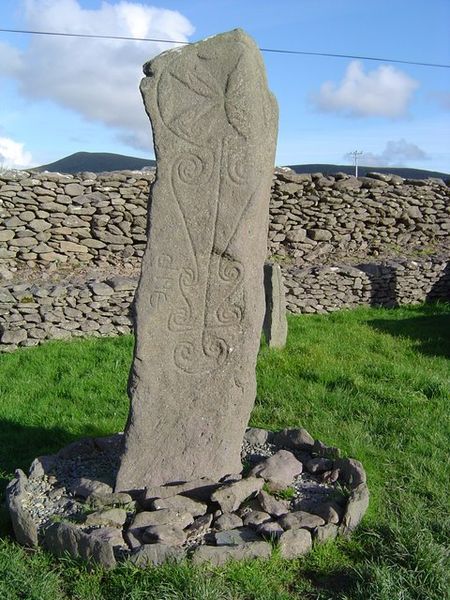Type: Cross Inscribed
Townland: An RiascThe Marsh

The stone has been at Reask since at least June 1838 when Windele drew and examined it, describing it as at
'Riesk about a quarter of a Mile SE of Ballinrannig ...' He returned there in September 1848.
When du Noyer examined and drew the stone in 1866, he described it at 'Valluragh Burial Ground 1 mile East of Ballyferriter Dingle', and 'on Dingle Road' ..
Macalister stated that the stone had been moved to University College Cork (Macalister/1949, 97), but, as Fanning pointed out, Macalister had confused this stone with one of the other, uniscribed, stones from Reask'.
Okasha/Forsyth/2001, 175--176:
'The back and sides are plain but the face is decorated with a full-length cross. This takes the form of a cross-of-arcs enclosed in a circle. In each angle of the arms a stem terminates in a double loop and tails, like a stylised ribbon bow. The cross stands on a linear shaft joined to the lower arm with a pair of inwardly disposed scrolls. The shaft terminates in a pelta and is further embellished by an irregularly shaped frame which incorporates three pairs of inwardly disposed scrolls'.
Okasha/Forsyth/2001, 176:
'Maltese (equal-armed) cross within a circle. The stem of the cross is decorated with spiral designs and terminates in a pelta-like motif. The cross is recessed into the stone with widely expanded arms, the lower member having two small spirals in slight relief. In the angles are traces of further lightly incised motifs probably representations of a capital omega...The remainder of the ornament is pendant from the encircled cross and is grouped around the vertical stem...and terminates in a spiralled pelta design. Directly above this a horizontal line is placed across the vertical stem so forming a cross the arms of which curl upwards into spirals. These are linked to a further set of S-curves...Finally the circle which encloses the cross curls downwards into two spirals linked with the lower spiralled designs by long attenuated S-curves, the entire curvilinear pattern forming a rough symmetrical frame to the central stem feature'.
Fanning/1981, 139--140:
Helene Brennan